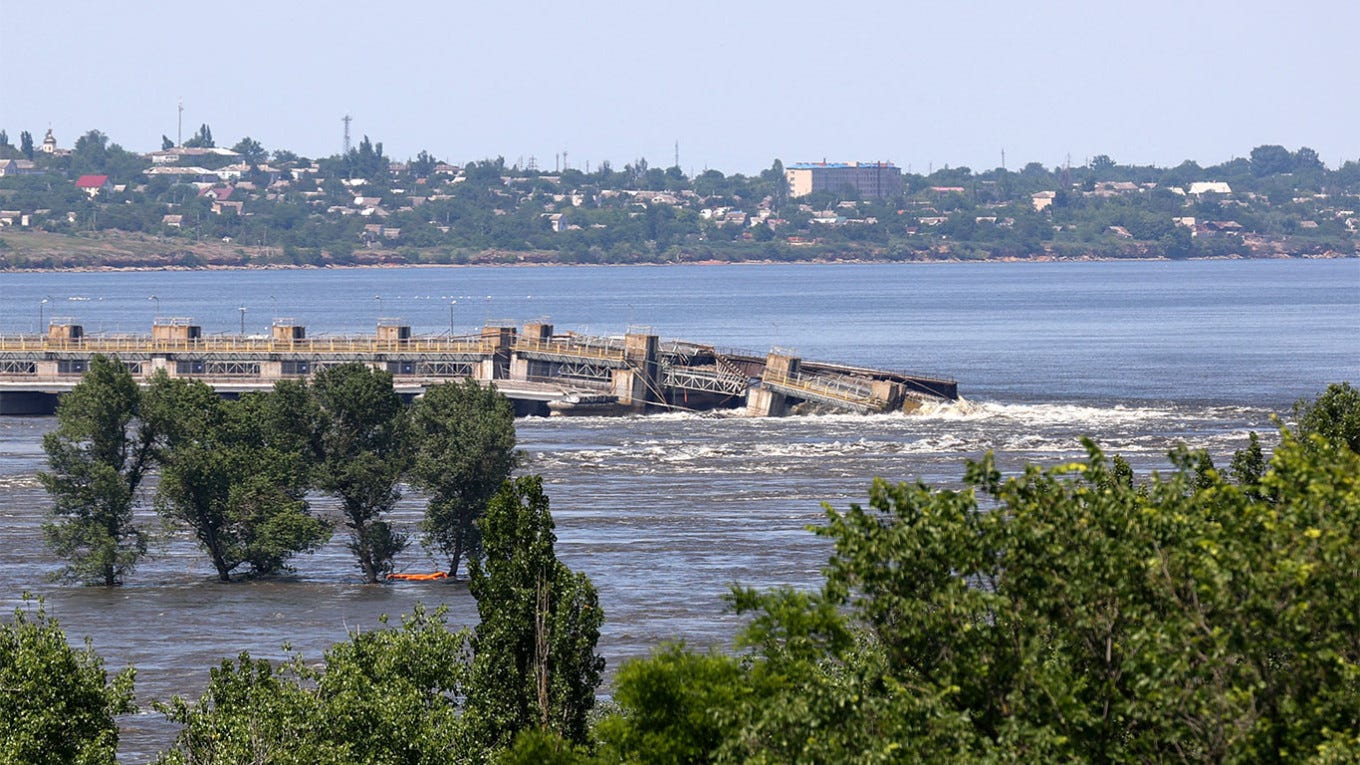A Word First
After months of frost, cold and floods, the war in Ukraine has been ramped up. The Ukrainian army has gone on the attack and taking significant losses. Read more.
From on High
"Having suffered heavy losses the day before, the Kiev regime reorganized the remnants of the 23rd and 31st mechanized brigades into separate consolidated units…”
The Russian Defense Ministry reports on Ukraine’s counter-offensive.
Spring is Here
The aftermath of the collapse of the Ukrainian dam on June 6.
Here's the difference between America and Russia. The U.S. military amasses tremendous firepower and tries to roll over the enemy in a mad dash toward its capital. The engagement can take weeks if not days.
The Russians have a completely different way of doing things in Ukraine. Their goal is to bleed Kiev until there's no fight left. The Russian military baits the Ukrainians to attack and then pummels them with massive air and rocket strikes. In a way, it's a return to the trench warfare of World War I.
The ground in Ukraine has thawed and Kiev, directed by Washington, has renewed operations. Ukraine's goal is foremost to demonstrate that it retains ground offensive capability and restore territory it lost to Russia over the last few months. Ukrainian troops, supported by nearly 300 Western main battle tanks, have been trying to advance along the front in Donetsk, particularly Bakhmut.
As usual, both sides have been claiming victories. But Kiev's advances have been so small -- as little as 300 meters -- that it seems to do little more than play into Russia's mincemeat strategy.
40:1 ratio
The price, Moscow says, has been high. On June 6, Russian Defense Minister Sergei Shoigu placed Ukrainian casualties at 3,175 over the previous two days. Shoigu said Ukraine also lost 52 main battle tanks.
In contrast, the Russian defense chief reported 71 Russian casualties and 210 injured. That would mean a kill ratio of more than 40:1 in favor of Moscow.
"During June 5, the enemy continued to conduct the offensive, concentrating the main efforts on the Vremevsky ledge of the South-Donetsk direction," the Russian Defense Ministry said. "Having suffered heavy losses the day before, the Kiev regime reorganized the remnants of the 23rd and 31st mechanized brigades into separate consolidated units, which continued offensive operations in the areas of the settlements of Novodarovka and Levadnoye. In addition, a fresh brigade was brought into battle in this sector."
What is clear is that Ukraine is being destroyed. On June 6, a major dam along the Dnieper River collapsed and flooding took place in dozens of nearby villages. Water and power supplies have already been interrupted. Both sides denied responsibility for the disaster.
How much fight is left?
How much fight is left in Ukraine? According to all independent sources, not much. The leaders of such NATO states as the Czech Republic and Hungary have already declared that the counter-offensive might be the last battle before serious negotiations begin.
For his part, Ukrainian President Volodymyr Zelensky has indicated that Kiev can no longer wait for the West to implement its promises of massive military aid. In other words, patience is no longer a luxury that he can afford. Already, Ukrainian and NATO sources report a huge shortage in Ukrainian manpower as well as poor supply lines and chaos along the front. The orders to attack are coming directly from NATO advisers rather than Ukrainian commanders.
The bottom line: There is pressure in both Europe and the United States for military successes to enable negotiations with Moscow by the end of 2023. Both continents have scheduled elections in 2024. The electorate in the West is sick of this war.
Meanwhile, Moscow has destroyed much of Ukraine. Nearly half of Ukraine's population has fled. More than 40 percent of the country's power and other utilities have been destroyed. Without basic services, life in Ukraine could become impossible once the rainy season returns in the autumn. At that point, Zelensky could be forced to his knees — or worse.



